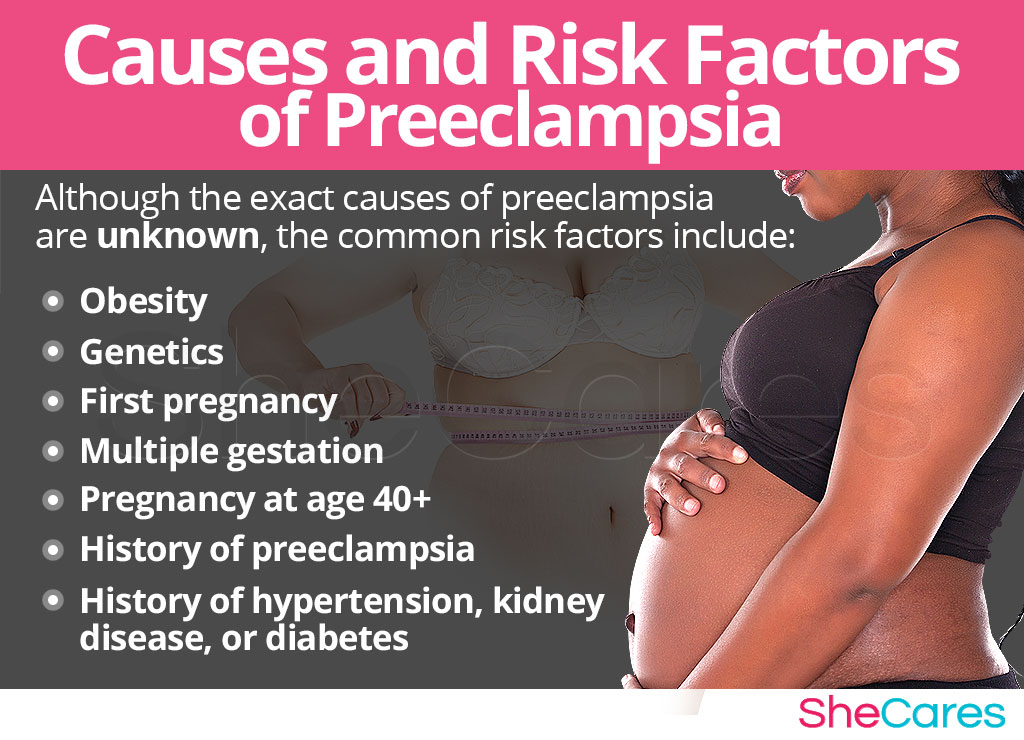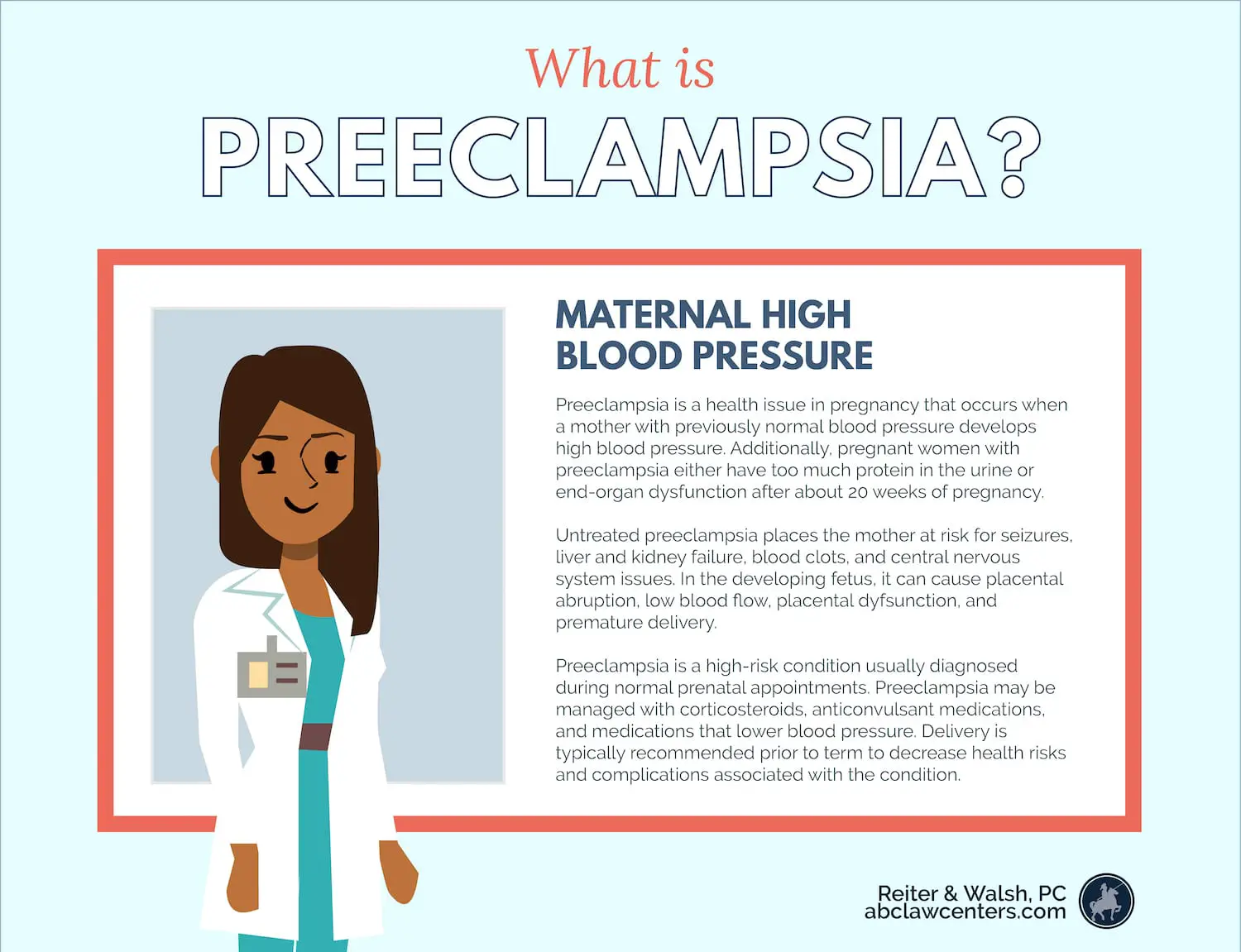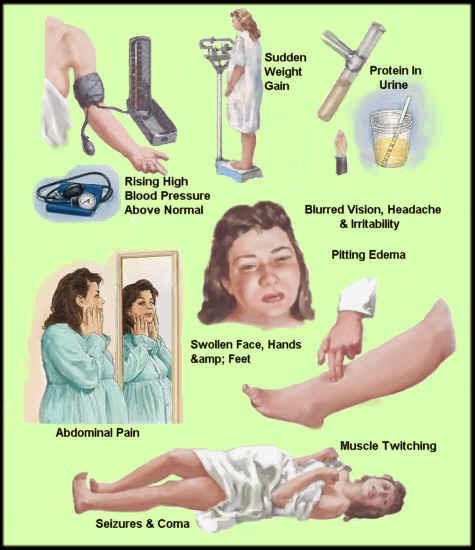What Is The Treatment
Treatment depends on how close you are to your due date. If you are close to your due date, and the baby is developed enough, your health care provider will probably want to deliver your baby as soon as possible.
If you have a mild case and your baby has not reached full development, your doctor will probably recommend you do the following:
- Rest, lying on your left side to take the weight of the baby off your major blood vessels.
- Increase prenatal checkups.
- Drink at least 8 glasses of water a day
- Change your diet to include more protein
If you have a severe case, your doctor may try to treat you with blood pressure medication until you are far enough along to deliver safely, along with possibly bed rest, dietary changes, and supplements.
Is There A Cure For Preeclampsia
There is not currently a cure for preeclampsia aside from delivery. The best treatment is usually relegated to a lack of strenuous activity, often bed rest. For cases of mild preeclampsia, this may be all that is necessary to keep the pregnancy going until the baby is viable or full-term. Bed rest isnt without risks, however, as it can increase the risk of blood clots. Medications, such as antihypertensives, corticosteroids, seizure prophylaxis during labor and anticonvulsants may also be necessary.
The goal of treatment is to keep the pregnancy healthy and the baby in the womb as long as possible. Sometimes bed rest is enough. But in more serious cases, the mother may require hospitalization until she delivers.
In severe cases of preeclampsia, doctors will most often schedule a Cesarean section . Mothers who are diagnosed towards the end of pregnancy, when the infant is viable, may have induced labor if a C-section is not necessary. This is so that the child stays as healthy as possible and doesnt go into fetal distress. If doctors dont manage labor carefully, the child can develop physical and neurological problems, and may have special needs well into childhood.
Unfortunately, because the only cure for preeclampsia is delivery, that often means women will need an emergency C-section and will delivery prematurely. This can further increase the risk of birth injuries. Infants born to mothers with this complication are at a higher risk of:
Signsymptoms And Causes Of Preeclampsia During Pregnancy
Preeclampsia during pregnancy is a serious complication that is characterized by uncontrollable high blood pressure. It results in severe damage to the various vital organ of the body, most commonly affecting the liver and kidneys. It normally develops after 20 weeks of gestation in women who previously didnt have high blood pressure. Left untreated, preeclampsia can lead to very serious even fatal complications for both you and your little one.
If you have preeclampsia, the most effective treatment is the delivery of your little one. Even after childbirth, it can still take a while for you to get better.
If youre diagnosed with preeclampsia too early in your pregnancy, it causes complications making it a challenging task for you and the doctor during delivery. Thats why your little one needs more time to develop, but you need to avoid putting yourself or your baby at risk of serious complications.
Rarely, preeclampsia occurs after delivery of a baby, a condition known as postpartum preeclampsia.
Read Also: Side Effects Of Donating Plasma While Pregnant
Care Preeclampsia With Severe Features
When preeclampsia with severe features is diagnosed after 34 weeks gestation, delivery is most appropriate. The mode of delivery should depend on the severity of the disease and the likelihood of a successful induction. Whenever possible, however, vaginal delivery should be attempted and cesarean section should be reserved for routine obstetric indications.
Women with preeclampsia with severe features who have nonreassuring fetal status, ruptured membranes, labor, or maternal distress should be delivered regardless of gestational age. If a woman with preeclampsia with severe features is at 32 weeks’ gestation or more and has received a course of steroids, she should be delivered as well.
Patients presenting with severe, unremitting headache, visual disturbance, and right upper quadrant tenderness in the presence of hypertension and/or proteinuria should be treated with utmost caution.
The Spectrum Of Preeclampsia/eclampsia

Preeclampsia is classified as one of the hypertensive disorders of pregnancy. It is generally defined as new onset hypertension with proteinuria during pregnancy, although the term is also used to describe worsening blood pressure and proteinuria in women with a history of chronic prepregnancy hypertension . The maternal syndrome consists of hypertension and proteinuria, which may also include multisystem abnormalities such as hemolysis, elevated liver enzymes, or low platelets syndrome disseminated intravascular coagulation acute renal failure seizures pulmonary edema . The fetal syndrome includes fetal growth restriction, small-size-for-gestational-age , reduced amniotic fluid, and placental insufficiency leading to fetal hypoxia and hypoperfusion. Preeclampsia can occur near or before term, with or without fetal complications .
Recommended Reading: How To Calculate Safe Period To Avoid Pregnancy
Prevention Of Stroke In Women
Vitamin D deficiency has recently emerged as an important potentially modifiable risk factor for both preeclampsia and stroke. Women who are deficient in vitamin D before or during pregnancy are at increased risk for preeclampsia . Low serum levels of 25D are very common in both developed and developing countries. In a population-based study of vitamin D intake and risk of preeclampsia, women with an estimated intake of 600800IU of vitamin D per day had reduced odds for preeclampsia compared to women with an estimated intake of less than 200IU/day . Trials of supplementation with calcium and vitamin D showed inconsistent effects on the risk of preeclampsia . Large ongoing trials of vitamin D supplementation in pregnancy as a strategy to prevent preeclampsia and other adverse pregnancy outcomes are ongoing. In a recent large electronic medical record database analysis, a 51% relative increase in stroke prevalence was noted in patients with very low versus normal vitamin D levels . The association between vitamin D deficiency and increased risk for both preeclampsia and stroke again suggests overlapping pathophysiology for these disorders.
How Can I Prevent Preeclampsia:
The exact cause of preeclampsia is not known. Its thought to be improper functioning of the placenta including insufficient blood flow to the placenta. Other factors that may increase risk include: high fat and poor nutrition immune function disorders genetic issues or a family history.
Currently, there is no sure way to prevent preeclampsia. Some contributing factors to high blood pressure can be controlled and some cant. Follow your doctors instruction about diet and exercise.
- Use little or no added salt in your meals
- Drink 6-8 glasses of water a day
- Avoid fried foods and junk food
- Get enough rest
- Your doctor may suggest you take the prescribed medicine and additional supplements
Also Check: Can I Use Vagisil Wash While Pregnant
Eclampsia And Your Baby
Preeclampsia and eclampsia affect the placenta, which is the organ that delivers oxygen and nutrients from the mothers blood to the fetus. When high blood pressure reduces blood flow through the vessels, the placenta may be unable to function properly. This may result in your baby being born with a low birth weight or other health problems.
Problems with the placenta often require preterm delivery for the health and safety of the baby. In rare cases, these conditions cause stillbirth.
Other Potential Causes Of Preeclampsia:
Recommended Reading: Can You Donate Plasma When Pregnant
Inheritance And Genetic Causes For Preeclampsia:
According to this theory, preeclampsia is genetically determined. Researchers are studying whether variations in genes involved in blood vessels and placental development affect the risk of developing preeclampsia or its severity.
The fetus carries genes from both parents. So, if the preeclampsia is genetically determined, the history of the condition on both sides of the family may raise the incidence of the disease.
But the results are still inconclusive. Preeclampsia occurs in many pregnant women with no known family history of the disorder, indicating the condition is not inherited. But on the other hand, there are families with a strong family history of preeclampsia, which suggests just the opposite.
Which Pregnant Women Are More At Risk
- A pregnant woman with twins or higher multiples is at a higher risk of developing preeclampsia.
- Pregnant women who are older than 35 or younger than 20 are considered at a greater risk.
- Obesity leads to conditions such as hypertension and other cardiovascular problems, which may cause preeclampsia.
- Preexisting health conditions, such as diabetes, high blood pressure, migraines, and kidney disease, may also cause preeclampsia.
- Socioeconomic status is associated with nutritional quality and environmental factors. Living in a polluted area or poor diet may lead to mineral and vitamin deficiency, resulting in health problems that may cause preeclampsia.
- Ethnicity has also been associated with preeclampsia risk. Black women are considered at a higher risk for developing preeclampsia.
RELATED: Risk factors for developing Preeclampsia
Don’t Miss: Can I Use Vagisil Wipes While Pregnant
Care In Preeclampsia Without Severe Features
Before 37 weeks, expectant management is appropriate. In most cases, patients should be hospitalized and monitored carefully for the development of worsening preeclampsia or complications of preeclampsia. Although randomized trials in women with gestational hypertension and preeclampsia demonstrate the safety of outpatient management with frequent maternal and fetal evaluations, most of the patients in these studies had mild gestational hypertension. Therefore, the safety of managing a woman with preeclampsia without severe features as an outpatient still needs to be investigated.
Although bedrest has been recommended in women with preeclampsia, little evidence supports its benefit. In fact, prolonged bed rest during pregnancy increases the risk of thromboembolism.
A pregnancy complicated by preeclampsia without severe features at or beyond 37 weeks should be delivered. Although the pregnancy outcome is similar in these women as it is in women with a normotensive pregnancy, the risk of placental abruption and progression to severe disease is slightly increased. Thus, regardless of cervical status, induction of labor should be recommended. Cesarean section may be performed based on standard obstetric criteria.
If a patient is at 34 weeks’ gestation or more and has ruptured membranes, abnormal fetal testing, or progressive labor in the setting of preeclampsia, delivery is recommended.
What Are The Causes Of Preeclampsia

According to the Mayo Clinic, the exact cause of preeclampsia involves several factors. Experts believe it begins in the placenta the organ that nourishes the fetus throughout pregnancy. Early in pregnancy, new blood vessels develop and evolve to efficiently send blood to the placenta.
In women with preeclampsia, these blood vessels dont seem to develop or function properly. Theyre narrower than normal blood vessels and react differently to hormonal signaling, which limits the amount of blood that can flow through them.
Causes of this abnormal development may include:
- Insufficient blood flow to the uterus
- Damage to the blood vessels
- A problem with the immune system
- Certain genes
Don’t Miss: Can You Get Lasik Eye Surgery While Pregnant
Frequently Asked Questions Expand All
Your obstetriciangynecologist should check your blood pressure at each prenatal care visit. Blood pressure changes often during the day. If you have one high reading, another reading may be taken later during your office visit.
Chronic hypertension is high blood pressure that a woman has before getting pregnant or that develops in the first half of pregnancy . If you were taking blood pressure medication before you got pregnanteven if your blood pressure is currently normalyou have been diagnosed with chronic hypertension.
When a woman is pregnant, her body makes more blood to support the fetuss growth. If blood pressure goes up during pregnancy, it can place extra stress on her heart and kidneys. This can lead to heart disease, kidney disease, and stroke. High blood pressure during pregnancy also increases the risk of preeclampsia, preterm birth, placental abruption, and cesarean birth.
High blood pressure may reduce blood flow to the placenta. As a result, the fetus may not get enough of the nutrients and oxygen needed to grow.
If your condition remains stable, delivery 1 to 3 weeks before your due date generally is recommended. If you or the fetus develop complications, delivery may be needed even earlier.
Classification And Characteristics Of Hypertensive Disorders
Preeclampsia is part of a spectrum of hypertensive disorders that complicate pregnancy. As specified by the National High Blood Pressure Education Program Working Group, the classification is as follows :
-
Gestational hypertension
-
Preeclampsia/eclampsia
-
Superimposed preeclampsia
Although each of these disorders can appear in isolation, they are thought of as progressive manifestations of a single process and are believed to share a common etiology.
Recommended Reading: Can I Put Braces While Pregnant
How We Help Women With Preeclampsia
Even if severe features are not present, preeclampsia can worsen suddenly, so we monitor these women closely. We recently had three patients who developed preeclampsia at 22 weeks. can predict a womans future heart disease riskThe best thing you can do is be aware of your risk and report any concerning symptoms to your doctor.request an appointment with usIf youre interested in receiving pregnancy trips and patient stories in your inbox, sign up for the Your Pregnancy Matters notification list. Well email you when new stories are published on our blog.
Pathophysiology Of Preeclampsia And Eclampsia
Pathophysiology of preeclampsia and eclampsia is poorly understood. Factors may include poorly developed uterine placental spiral arterioles , a genetic abnormality on chromosome 13, immunologic abnormalities, and placental ischemia or infarction. Lipid peroxidation of cell membranes induced by free radicals may contribute to preeclampsia.
You May Like: Is It Safe To Take Tums While Pregnant
Eclampsia Symptoms & Outcomes
Seizures that occur with eclampsia are usually generalized seizures, meaning the woman loses consciousness and experiences jerking movements and incontinence. Approximately 30 to 50% of eclamptic patients also experience HELLP syndrome, which means that the bodys blood-clotting systems dont work as they should.
Who Is At Risk Of Pre
It is difficult to predict who will be affected, but certain women appear to be more at risk than others, including women who:
- are having their first pregnancy
- have pre-existing high blood pressure
- have a family history of the condition
- have diabetes
- are pregnant with more than one baby in the womb.
Don’t Miss: Nutraburst While Pregnant
Signs And Symptoms Of Preeclampsia
Signs and symptoms of preeclampsia during pregnancy include:
-
A persistent headache
-
Seeing spots or other changes in vision
-
Pain in the upper abdomen or shoulder
-
Nausea and vomiting
-
Sudden weight gain
-
Sudden swelling in face and hands
-
Difficulty breathing
Some of these symptoms are also normal symptoms of pregnancy, so it can be difficult to tell when something is wrong. Go straight to your healthcare provider or visit the emergency room if you notice preeclampsia warning signs such as severe headaches, severely blurred vision, severe pain in the abdomen, or severe shortness of breath.
What Are The Treatments For Preeclampsia

Delivering the baby can often cure preeclampsia. When making a decision about treatment, your provider take into account several factors. They include how severe it is, how many weeks pregnant you are, and what the potential risks to you and your baby are:
- If you are more than 37 weeks pregnant, your provider will likely want to deliver the baby.
- If you are less than 37 weeks pregnant, your health care provider will closely monitor you and your baby. This includes blood and urine tests for you. Monitoring for the baby often involves ultrasound, heart rate monitoring, and checking on the baby’s growth. You may need to take medicines, to control your blood pressure and to prevent seizures. Some women also get steroid injections, to help the baby’s lungs mature faster. If the preeclampsia is severe, you provider may want you to deliver the baby early.
The symptoms usually go away within 6 weeks of delivery. In rare cases, symptoms may not go away, or they may not start until after delivery . This can be very serious, and it needs to be treated right away.
You May Like: Lasik During Pregnancy
How Do Doctors Diagnose Preeclampsia
Preeclampsia testing usually involves monitoring your blood pressure during prenatal visits. Blood pressure of 140/90 millimeters of mercury or more on two occasions at least four hours apart is abnormal. Make sure you tell your healthcare provider if you have noticed any signs of preeclampsia, as this will assist in making a diagnosis. Your provider may perform further preeclampsia tests such as:
-
Blood tests to look at liver function, kidney function, and the level of blood platelets
-
Urine analysis to check the amount of protein in your urine
-
Fetal ultrasound to monitor your baby’s growth, estimate her weight, and check the amount of amniotic fluid
-
Non-stress test to check how your baby’s heart rate reacts when she moves
-
Biophysical profile to measure your baby’s breathing, muscle tone, and movement.
How Is Eclampsia Treated
To prevent eclampsia, magnesium sulfate is given intravenously to patients with severe preeclampsia. Magnesium is also given to patients with eclampsia to prevent more seizures. This treatment should only be performed in the hospital under close supervision of a general obstetrician since overdoses can occur.
It can be easy to worry that you may experience eclampsia if youve experienced symptoms of preeclampsia. However, if you find yourself with preeclampsia, you can rest assured that you and your baby will be monitored as carefully as possible for a positive pregnancy outcome.
Recommended Reading: Can Donating Plasma Hurt An Unborn Baby
